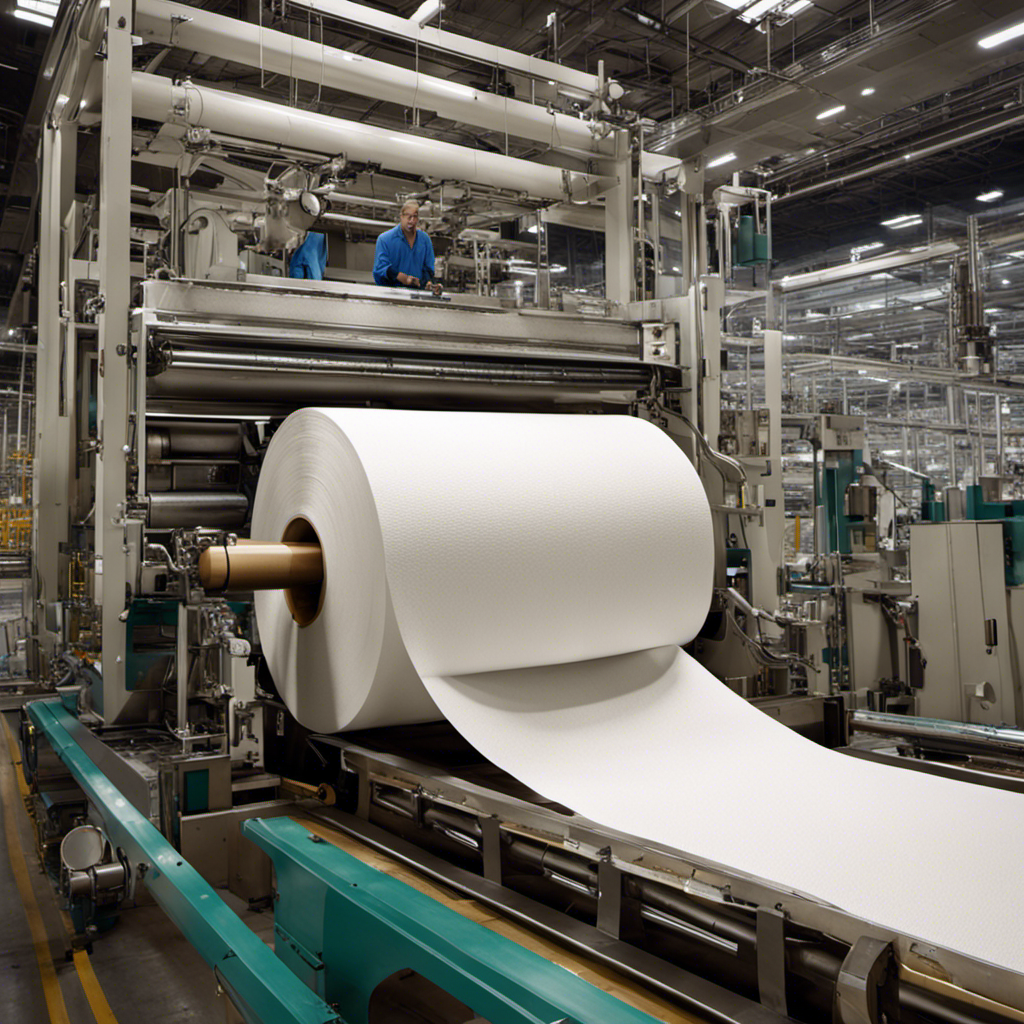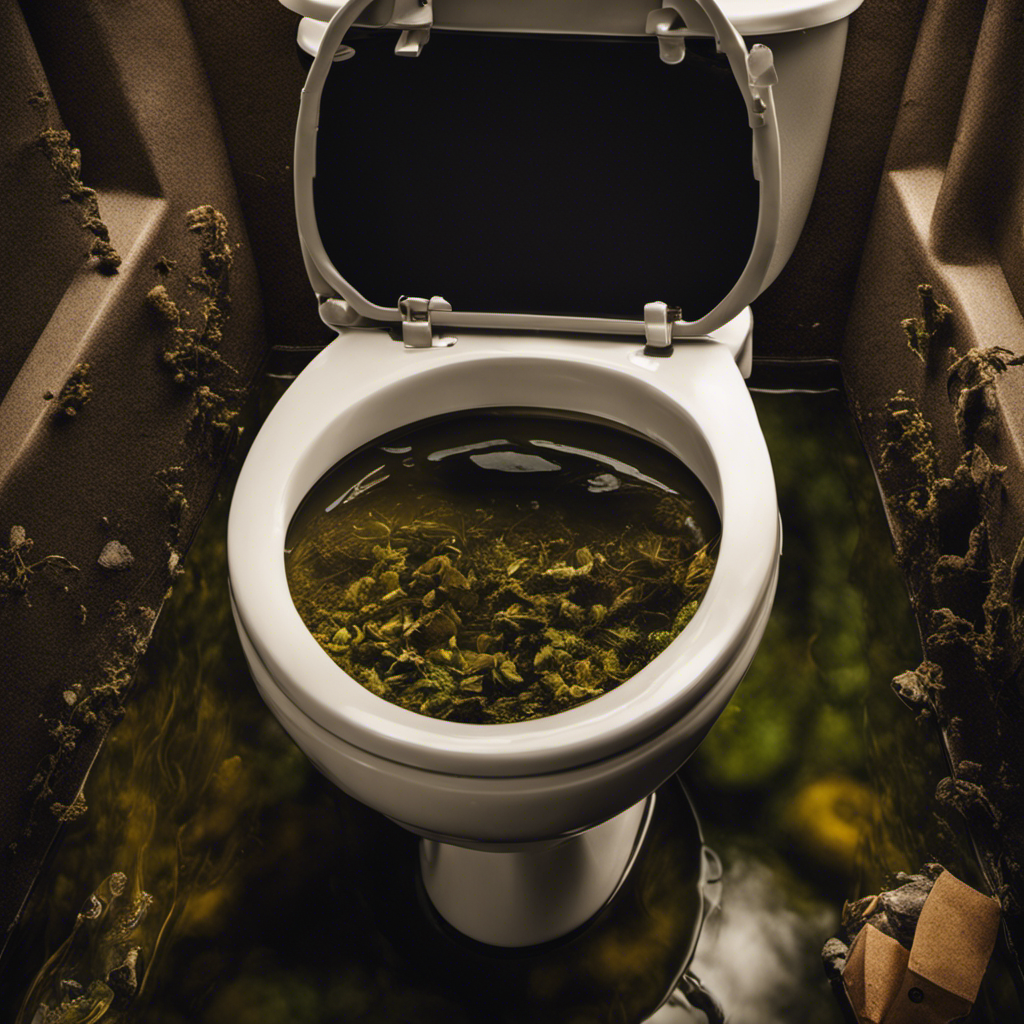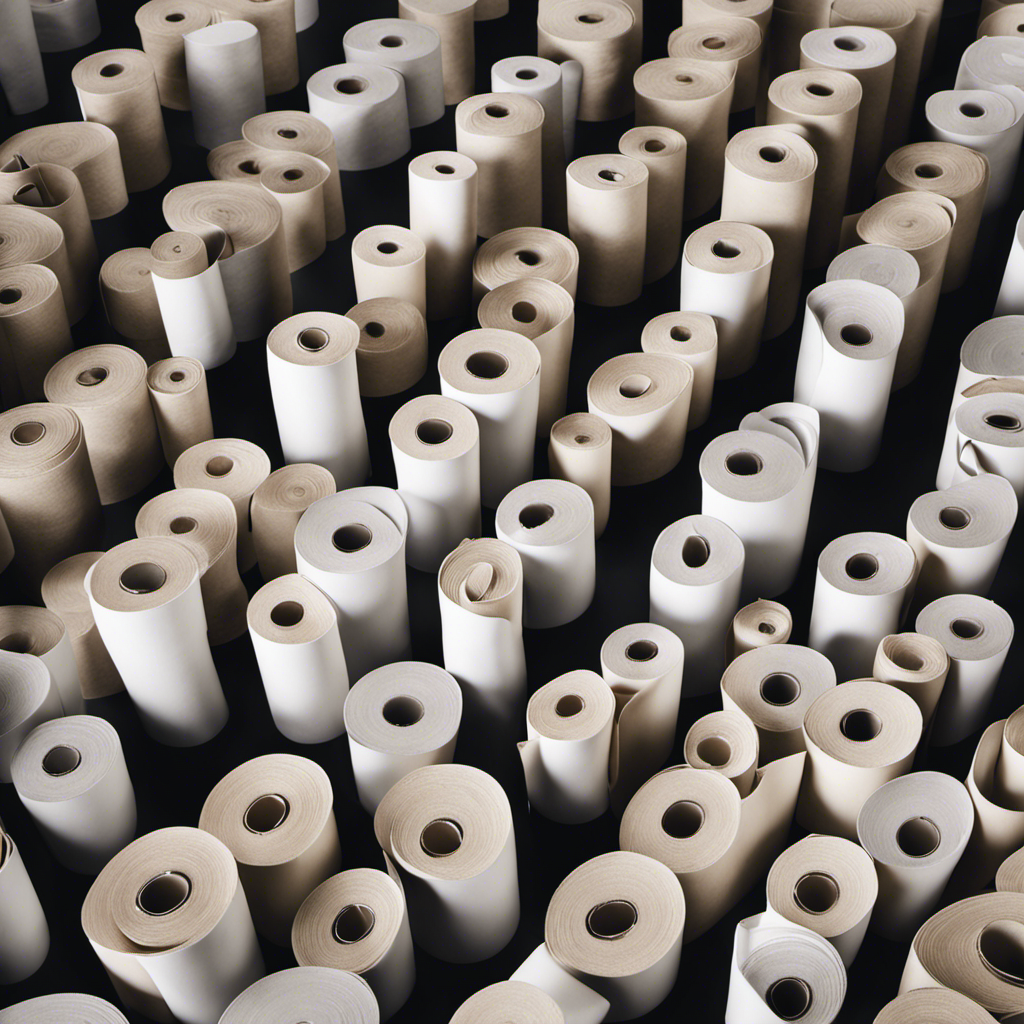As a manufacturing analyst, I am constantly fascinated by the intricate processes behind everyday products. One such item that we often take for granted is toilet paper.
In this article, we will delve into the fascinating world of toilet paper production, exploring the history, raw materials used, and the intricate steps involved in creating this essential product.
From the paper making process to the packaging and distribution, we will leave no roll unturned in our quest to understand how it’s made.
Key Takeaways
- Toilet paper is made from wood pulp and recycled paper, which are mixed with water to form a slurry and pressed into paper web.
- The paper making process involves breaking down raw materials into a fibrous mixture, feeding it into large paper machines, and drying it to remove moisture.
- Quality control measures are in place to ensure uniformity, consistency, thickness, texture, and durability of the toilet paper.
- The industry is actively researching and developing sustainable methods and materials for toilet paper production, including the use of recycled fibers and alternative fibers like bamboo and hemp.
The History of Toilet Paper Production
The history of toilet paper production dates back to ancient China. It is fascinating to see how this essential product has evolved over time.
In ancient China, toilet paper was made from the bark of mulberry trees. The bark was soaked, boiled, and then beaten into a pulp. This pulp was then spread out and pressed into thin sheets, which were left to dry in the sun. The process was labor-intensive and time-consuming.
However, as time went on, the production methods became more efficient and advanced. Today, toilet paper is made using a combination of wood pulp and recycled paper. It is processed through a series of steps, including pulping, bleaching, pressing, and drying. These advancements in production techniques have allowed for the mass production of toilet paper, making it readily available to people worldwide.
Now let’s delve into the raw materials used in toilet paper manufacturing.
Raw Materials Used in Toilet Paper Manufacturing
You can’t produce toilet paper without using raw materials like wood pulp or recycled paper. In the manufacturing process, raw material sourcing plays a crucial role.
For wood pulp, trees are harvested from sustainably managed forests. The logs are then debarked and chipped into small pieces. These chips are chemically treated to remove impurities and break down the wood fibers. The resulting pulp is bleached to achieve the desired whiteness.
Recycled paper, on the other hand, goes through a deinking process to remove ink and other contaminants.
Both raw materials are then mixed with water to form a slurry. This slurry is then pressed and dried on large rotating drums to remove excess water and create the paper web.
The environmental impact of raw material sourcing is a concern, but the industry is taking steps to ensure sustainable practices are followed, such as responsible forestry and increased use of recycled paper.
The Paper Making Process
Start by gathering all the necessary raw materials for the paper making process.
The first step in manufacturing toilet paper is preparing the pulp. This involves breaking down the raw materials, such as wood chips or recycled paper, into a fibrous mixture.
Once the pulp is ready, it is fed into large paper machines. These machines have screens and rollers that help remove excess water and create a continuous sheet of paper.
The paper then goes through a drying process, where it is heated and passed through heated rollers to remove any remaining moisture. This ensures that the paper is strong and ready for further processing.
The drying process is crucial in maintaining the quality and integrity of the toilet paper.
How Toilet Paper Is Cut and Shaped
When it comes to the cutting techniques used in the production of toilet paper, precision is key. The rolls are carefully cut to ensure uniformity and consistency in size.
The shaping process involves shaping the rolls into the familiar cylindrical shape, with attention paid to the edges for a smooth finish.
Quality control measures are implemented throughout the process to ensure that each roll meets the highest standards. Checks for thickness, texture, and overall durability are conducted.
Cutting Techniques Used
One common cutting technique used in the production of toilet paper is rotary cutting. This method involves using a rotating blade to cut large rolls of paper into smaller, individual rolls. It is a highly efficient and precise technique that ensures consistent sizing and shape of the toilet paper rolls.
To evoke emotion in the audience, let’s consider the following sub-lists:
-
Benefits of rotary cutting:
-
Uniformity: The rotary cutting technique ensures that each roll of toilet paper is the same size and shape, providing a consistent experience for consumers.
-
Efficiency: By using rotary cutting, manufacturers can quickly cut large rolls into smaller ones, allowing for increased production rates and meeting high demands.
-
Challenges of rotary cutting:
-
Blade maintenance: The blades used in rotary cutting need to be regularly sharpened and replaced to maintain their effectiveness and prevent any damage to the paper.
-
Initial investment: Implementing rotary cutting in the production process requires significant investment in specialized machinery, which may pose a financial challenge for some manufacturers.
Overall, rotary cutting is an effective method for achieving precise and efficient roll formation in toilet paper production.
Shaping Process Explained
To shape the rolls, you’ll need to stack and compress the cut sheets of paper using a specialized machine. This process is crucial in creating the final product with the desired shape and thickness.
The sheets of paper are stacked on top of each other, forming a tall pile. The machine then applies pressure to compress the stack, making it more compact. This compression helps to eliminate any air gaps and ensures uniformity in the roll’s shape and size.
The challenge in this shaping technique lies in maintaining consistent pressure throughout the stack to avoid any variations in thickness. Manufacturing challenges include the proper alignment of the sheets and the control of compression force to achieve the desired result.
Quality Control Measures
After the shaping process is completed, the next step in manufacturing toilet paper is the implementation of quality control measures. As a manufacturing analyst, ensuring the highest standards of quality is of utmost importance to me. To achieve this, we conduct rigorous quality inspections and product testing throughout the production process.
Here are some key aspects of our quality control measures:
-
Quality Inspection:
-
Visual inspection for any visible defects or imperfections.
-
Measurement checks to ensure the correct dimensions and thickness of the toilet paper.
-
Product Testing:
-
Strength and durability tests to ensure the toilet paper can withstand regular usage.
-
Absorbency tests to guarantee effective performance.
By implementing these quality control measures, we can ensure that every roll of toilet paper that leaves our manufacturing facility meets the highest standards of quality. This attention to detail ensures customer satisfaction and trust in our brand.
Now, let’s move on to the next step: adding fragrances and colors to toilet paper.
Adding Fragrances and Colors to Toilet Paper
When it comes to adding fragrances and colors to toilet paper, two key points to consider are the effectiveness and safety of the fragrances used, as well as consumer preferences for colors.
As a manufacturing analyst, it is important to ensure that the fragrances used are not only pleasant but also effective in neutralizing odors.
Additionally, understanding consumer preferences for colors can help guide decisions on which colors to incorporate into toilet paper designs, ensuring that it appeals to a wide range of consumers.
Fragrance Effectiveness and Safety
The fragrance used in toilet paper can greatly impact its effectiveness and safety. When it comes to fragrance safety, it is important to consider the potential risks of using scented toilet paper. Fragrances can cause allergic reactions in some individuals, leading to skin irritation or respiratory issues.
Therefore, it is crucial to choose fragrance-free options for those with fragrance allergies or sensitivities. On the other hand, for those who enjoy scented toilet paper, it is essential to ensure that the fragrance used is safe and non-irritating. Manufacturers should carefully select fragrances that are hypoallergenic and undergo rigorous testing to ensure they meet safety standards.
By prioritizing fragrance safety, we can enhance the overall experience of using toilet paper without compromising on the well-being of consumers.
Speaking of consumer preferences, let’s now delve into the topic of color choices for toilet paper.
Consumer Preferences for Colors?
After examining the effectiveness and safety of fragrances in toilet paper, it is important to consider consumer preferences for colors. When it comes to toilet paper, consumers have varied preferences regarding the color of the product. While some individuals may prefer traditional white toilet paper, others may opt for colored options to add a touch of personalization to their bathrooms. As a manufacturing analyst, it is crucial to understand these consumer preferences and incorporate them into the production process. However, it is equally important to consider the environmental impact of using dyes or pigments to color toilet paper. Balancing consumer preferences with sustainable manufacturing practices is key in meeting the demands of the market while minimizing the ecological footprint. By taking these factors into account, we can ensure that the production of colored toilet paper meets both consumer expectations and environmental standards.
Transitioning into the subsequent section about packaging and distribution of toilet paper, it is essential to address the ways in which these products are packaged and delivered to consumers.
Packaging and Distribution of Toilet Paper
Toilet paper is typically packaged and distributed in large rolls for convenience. The packaging innovations in the toilet paper industry have come a long way to meet the changing needs of consumers. Companies are now focusing on sustainability efforts by using eco-friendly materials for packaging.
Here are two sub-lists that will evoke emotion in the audience:
-
Benefits of packaging innovations:
- Easy to use and store
- Keeps the toilet paper clean and hygienic
-
Importance of sustainability efforts:
- Reduces environmental impact
- Supports responsible consumption and production
The manufacturing process of toilet paper involves precise steps and measurements. It starts with cutting large rolls into smaller ones, followed by perforating and embossing the paper. The paper is then wound onto a core and packaged using sustainable materials.
These packaging innovations and sustainability efforts are just the beginning of the industry’s commitment to improving the manufacturing process. As we move forward, there are even more exciting innovations and future trends in toilet paper manufacturing to explore.
Innovations and Future Trends in Toilet Paper Manufacturing
As we continue exploring the manufacturing process of toilet paper, it is important to address the growing concern for toilet paper sustainability and the demand for eco-friendly alternatives. Many consumers are now seeking options that are not only soft and absorbent but also environmentally friendly.
In response to this need, manufacturers are actively researching and developing innovative methods and materials for toilet paper production. One such trend is the use of recycled fibers in the manufacturing process. By utilizing recycled paper, manufacturers can reduce the reliance on virgin wood pulp and minimize deforestation.
Additionally, there is a rising interest in the use of alternative fibers such as bamboo and hemp, which are known for their fast-growing nature and minimal environmental impact. These eco-friendly alternatives offer the potential to further reduce the ecological footprint of toilet paper production.
Overall, the industry is committed to finding sustainable solutions that balance the demand for toilet paper with environmental concerns. By embracing these innovations and future trends, we can contribute to a more environmentally conscious approach to toilet paper manufacturing.
Frequently Asked Questions
What Are the Different Types of Toilet Paper Available in the Market?
There are various types of toilet paper available in the market, including scented and luxury options. They offer different features and qualities to cater to individual preferences and needs.
How Is Toilet Paper Tested for Quality and Durability?
In toilet paper manufacturing, quality and durability are tested through a series of strength tests. These tests measure factors like tensile strength, tear resistance, and absorbency to ensure that the toilet paper meets industry standards and customer expectations.
Are There Any Environmental Concerns Associated With Toilet Paper Production?
Toilet paper production raises concerns about water pollution and energy consumption. It’s essential to address these environmental issues by implementing sustainable practices, such as using recycled materials and reducing water usage during the manufacturing process.
Can Toilet Paper Production Cause Deforestation?
Toilet paper production can cause deforestation, impacting wildlife. The demand for wood pulp, a key ingredient in toilet paper, leads to the destruction of forests. This can disrupt ecosystems and harm species that rely on these habitats.
Is Recycled Toilet Paper as Effective as Regular Toilet Paper?
Recycled toilet paper is just as effective as regular toilet paper. While the manufacturing process may differ, both options provide the same functionality. It’s important to consider the environmental impact of toilet paper production and choose sustainable options.
Conclusion
In conclusion, the manufacturing process of toilet paper is a finely tuned symphony of raw materials, intricate machinery, and precise measurements.
From the history of its production to the packaging and distribution, every step is carefully orchestrated to ensure a seamless experience for the consumer.
Innovations in fragrance and color have added a touch of artistry to this essential product.
As a manufacturing analyst, I am amazed by the attention to detail and the dedication of the industry in providing a high-quality product.
The future holds exciting possibilities for further advancements in toilet paper manufacturing.










